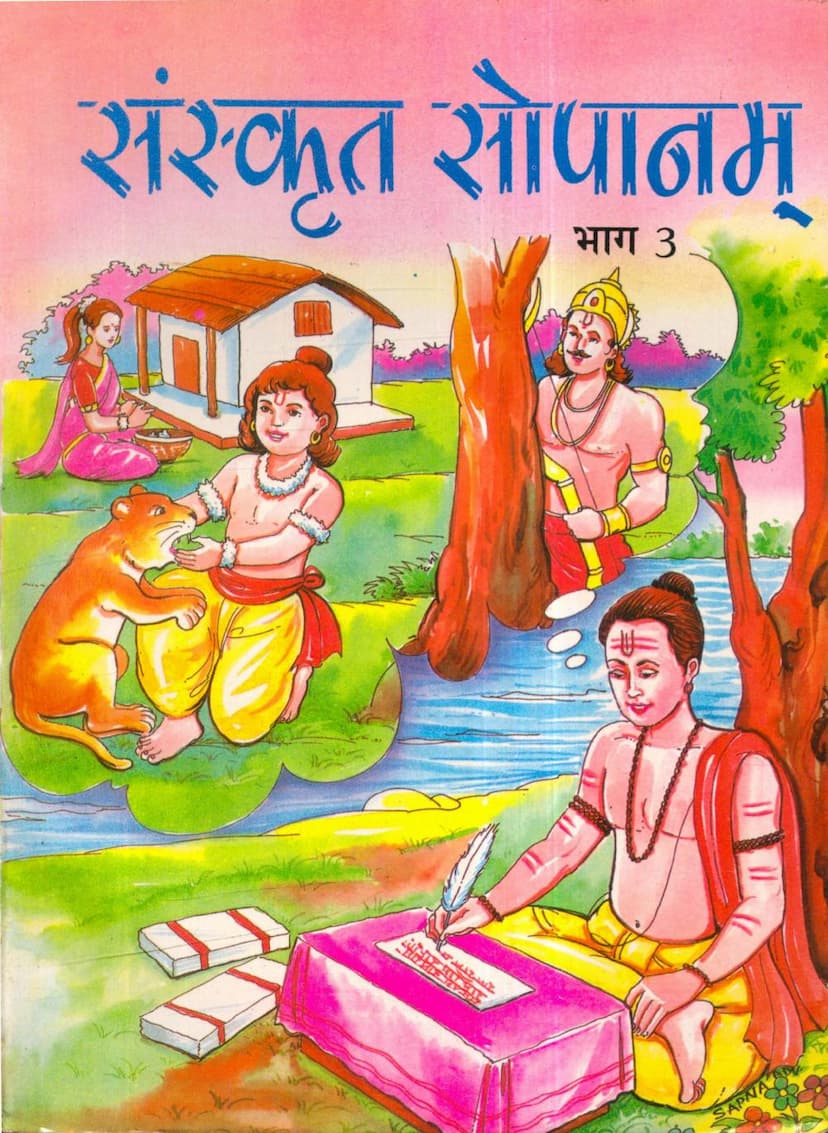Sanskrit Sopanam Part 03
Added to library: September 2, 2025

Summary
This Sanskrit text, "Sanskrit Sopanam Part 03," authored by Surendra Gambhir and published by Pitambar Publishing Company, is a comprehensive textbook designed for learning Sanskrit. The book aims to teach Sanskrit through a structured and gradual approach, incorporating elements of language psychology and pedagogical best practices.
Here's a breakdown of its key features and content:
Pedagogical Approach:
- Holistic Language Learning: The book emphasizes all four aspects of language learning: listening, speaking, reading, and writing. However, it prioritizes reading and comprehension for Sanskrit, with speaking and other skills introduced as supplementary tools to build confidence and interest.
- Gradual Progression: The curriculum is meticulously designed to ensure a strong foundation. Vocabulary, sentence structure, and grammar are introduced incrementally and systematically, making learning accessible for beginners.
- Engaging Content: The textbook includes a variety of material to keep students interested:
- Simple Sanskrit poems and sentences from daily life at the beginning to foster affection for the language.
- Literary excerpts, stories, and examples from Sanskrit literature.
- Lessons covering diverse topics like science, culture, and social knowledge.
- Learning Aids: Each lesson is supplemented with:
- Teaching Points: Clearly outlines the grammatical concepts or vocabulary being taught.
- Vocabulary (शब्दार्थाः): Provides definitions for new words.
- Grammatical Forms (रूपाणि): Details declensions and conjugations.
- Adjectives (विशेषणानि): Explains gender and number agreement.
- Indeclinables (अव्ययाः): Lists and explains the usage of indeclinable words.
- Exercises (अभ्यासः): Includes both oral and written exercises, with translation tasks and word-building activities to reinforce learning.
- Notes (विशेषः): Offers explanations on grammatical nuances and linguistic concepts.
- Focus on Understanding: The author emphasizes that the goal is not to overload students but to build their capacity through consistent effort.
Content Overview (Based on the lesson titles):
The book is structured into 24 lessons, covering a wide range of topics and grammatical structures. Here's a glimpse of the content:
- Lessons 1-5: Focus on foundational grammar, including declensions of nouns like Bhanu (sun), Nadi (river), and numerals like Eka (one), Dvi (two), Tri (three), Chatur (four). Topics include prayers, fables (like the lion and the mouse), geographical descriptions (Himalaya), health, and sports.
- Lessons 6-10: Introduce more complex grammar, including verb conjugations and more declensions. Stories feature themes of fate (three fishes), famous figures like Shri Rama, a visit to the zoo, the story of Nala and Damayanti, and fables like the donkey's song.
- Lessons 11-15: Cover aspects of Indian history and culture, including the life of Buddha, the teachings of the Gita, and descriptions of India. Grammar includes declensions of words like Saptin, Chatur, Bhagavat, and Dhatri.
- Lessons 16-20: Focus on national pride and values, including an introduction to India, poetry with moral lessons, and the concept of karma yoga. Grammar includes comparative and superlative adjectives, declensions of words like Yashas and Yug, and the use of prefixes.
- Lessons 21-24: Deal with various aspects of Sanskrit language and literature, including the history of Sanskrit, the story of Vivekananda, and the "three 'Da'" concept from the Puranas. Grammar includes declensions of words like Payas, Shashin, and pronouns like Kim, Yat, Any. The final lessons also cover grammar rules like Sandhi, verb conjugations, and declensions of different types of nouns.
Grammar and Vocabulary Focus:
The book systematically introduces:
- Noun Declensions: Covers various noun types like Bhanu, Nadi, Shashin, Dhatri, Bhagavat, Kim, Yat, Any, Sarva, Anek, Purva, Payas, etc., in different cases and numbers.
- Verb Conjugations: Teaches verbs in various tenses (Lat, Lut, Lang), moods (Lot, Vidhilin), and aspects, including regular and irregular verbs.
- Sandhi Rules: Explains different types of Sandhi, including Dirgha, Guna, Vriddhi, Yan, and Visarga Sandhi.
- Adjective Usage: Emphasizes agreement between adjectives and nouns in gender, number, and case.
- Indeclinables (Avyay): Provides a comprehensive list and their usage.
- Numerical Words: Introduces numbers up to 100.
- Idioms and Special Usages: Highlights common idiomatic expressions and grammatical peculiarities.
Overall Purpose:
"Sanskrit Sopanam Part 03" is a well-structured and comprehensive resource designed to guide students from intermediate to advanced levels of Sanskrit proficiency. It balances grammatical accuracy with engaging content, aiming to foster a deep appreciation and understanding of the Sanskrit language and its rich literary heritage. The book's systematic approach, ample exercises, and clear explanations make it an effective tool for both self-study and classroom learning.